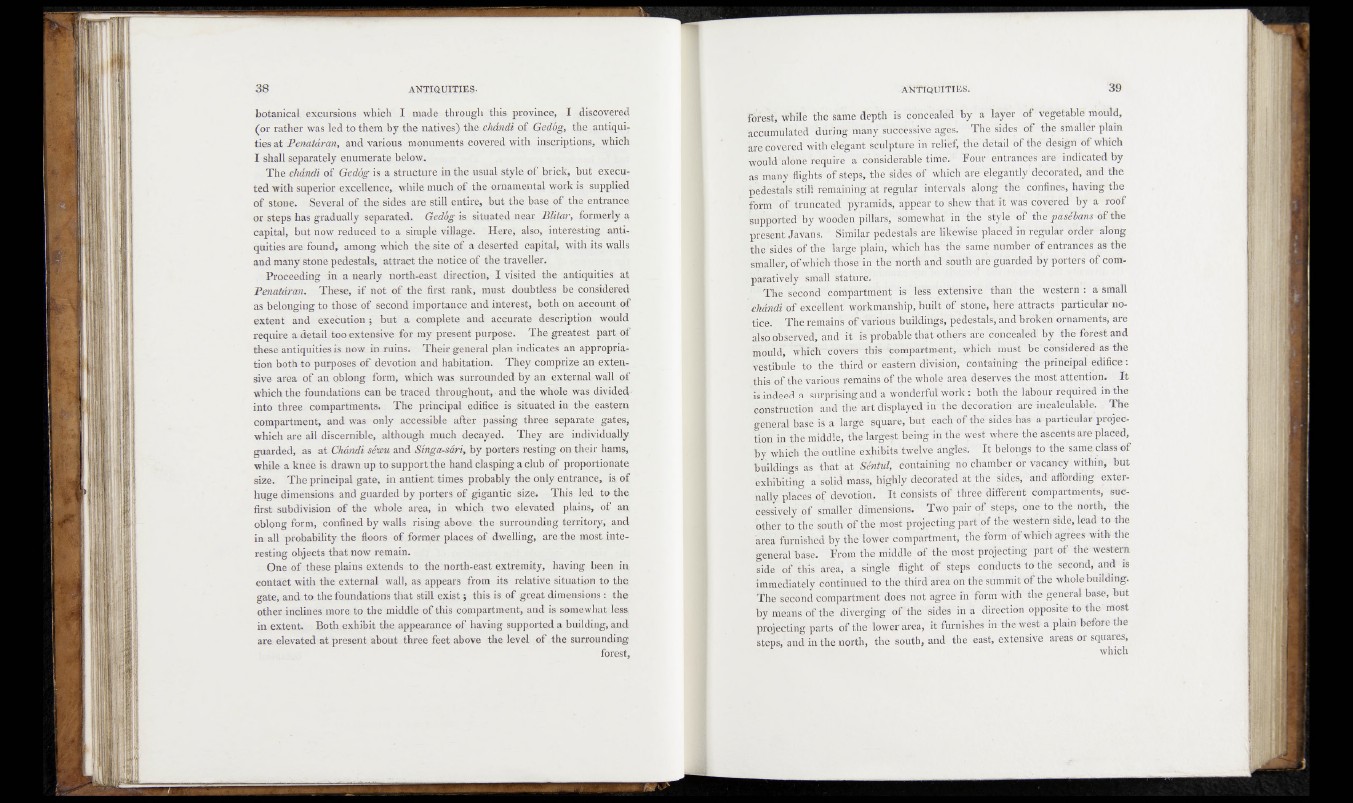
botanical excursions whichl/I made-through this province, I discovered
(or rather was ledHto them, by the natives). the, ckdndi of (Sed^g, theantiqni.
ties at Penataran, and various monuments coveredjwith inscriptions, wjjich
I sfaah separately enumerate below,,: .
The cMmft of Gedóg is a structure i» the usual &tyiejp^rbriek, but, execu-
ted with superior excellence,.: white much, of the vótn.amqntal work ^ippplied
of stone, ' Several of the.sides are stiU entire, but the base ofthe pntrance
or steps has gradually separated. Gtedég is situated near Blitqr, forineriy q
capital, but noW'redu^d. to a simple village. Here», alsosj-'inter^ting, antw
quities are found, among which the site of a deserted capital, with its walls
ami many stone pedestals, attract themotiee of the traveller.
Proceeding in a nearly north-east, Sectie», I visited the antiquities] at
Penataran., These, i f hot of the first, rank, must doubtless fee, considered
as belonging to thoseof second importance and interest, both on account, of
extent and execution; but a complete and accurate descriptie» would
require a, detail too extensive for my present purpose. Thegteatost: part Of
these antiquitiesis. now in ruins. Their general .plair indicates an appropria*
tion both to purposes of devotion and habitation. They cbmgfcika au.exteu-!
sive area of an oblong form, which was, surrounded by. aoj jsxternsal.- wall of
which the foundations can he traced throughout,r and the whole, was divided-
into three compartments. The principal edifice, i& Situated in the, eagteTO
compartment, and was only accessible after passing three .separate’ gates,
which mma# disceeniMe, although much decayed- , Ishfiy ate individually
guarded^ as at. Chandi séwu and Sbiga-s&ri-, by porters resting opt their hams,,
white a knee is. drawn up to support, the hand clasping a club of proportionate
size. The principal gate, in antient times probably the ojaly- entrance^ ia of
huge dimensions and guarded by porters of gigantic stee.;- This led-- f t the
fust subdivision ©f the whole area, in whiplt two elevated plains, of an
oblong form, confined by walls rising above, the surrounding terjjitpfyi; and
in all probability the doors of forinerplaces of dwelling, are the- te©.st. interesting
objects that now remain.
One of- these plains extends to the. north-east extremity, having been in
contact with the external wall, as, appears from its retetiv© situation to the
gate, and to. the foundations that still exists this, is o# great dimensions; the
©thet inriines. morei to the middle of this eompattment, and is somewhat less;
in, extent. Both exhibit the, appearance of having supported a building, and
are elevated at present about three feet above the level of,the surrounding
forest,
Ïôïesti •frtiïté th'e same depth1 is^hcfe'aled'bÿ à ïayfer of vegetable mould,
‘âëdrimtilSfe^Jlk û r ^ 'lman3^ ^ ^ ^ s l r e ^ ^ l s ^ 'f'The sides- of the stóaller plain
âre^o-^fl.d"1 With'elegant 'sctiljlïuie in teîilf^ttpIMfMiî'of the' design of which
'Whïd^tórïe r é ^ ^ ,fâfiCÎ)Mâêi!£bîe: lirrreV■ Poiii^ entraînées ate - indicated by
alfftany-flights1 otfStejrs, t h e ^ ^ ^ w t e ç M ^ 4 t ^ ^ i t l y Tdécoratted, «and the
pedestal's ifeï'îfeinàfc'ihg*tü r^ à la r' 'intervals àî drig'1'tlte J'cóhfinss, having the
fe’m ï' oF^rdnfêtéd ^?amds,^â™êâr td’^héw'tKdt1^; 'wai1 cövéréd by a rodf
's n p ^ ó ^ # b 3 ^ 5 fe ff^ ilP a f e '?sWelw b a t'ih 'fe e te§ të ‘fef thêrpdsëians<öf the
present'Ja^hns. * femèa$ p è d e S ^ a t ê 'l ï f ^ é 'l ^ c è d 'in regular order along
thé-JidM'of ' - ^ ^ g e 'plain, w h i 'c l ^ i ^ e s aM numbér óferitrabbes' ds the
smidlër' ófwhicy^Móm tM m f th 'y i^ s ï^ P a f e guarded by porters of cotrt-
pmatiYéiy- ‘ femall Statute", ‘ 1
‘ ‘The ?s\Te*ssfiéxtènsivér,tfian the western: a small
^cMWi’f)f-ëxcèïld^ huift of stonè,'HërMrabts particular ndrtfCe:
ÈTbe remain^ ’oPyarious Buildingé,' befleëfklsi-knd^rbk'dn ornaments, are
^f^q^erv^d;"ând' ÎÏ fe-pi0;btble'that%tA%l^fe bbhcëaMd! b ÿ fee' forest and
■ fp Juldf tenmpar trnent^w.hrchrm ük’t be'cónsüdered-as the
u ib tw m l& ^ WémërA ^isidff/'nöfi&ïftlh^ fee-principal edifice-,
jthis- o f the various remains of'îbe'wHôIé ârea‘‘ÜèYèrvès îb^m p t attention.-- It
'îsindeèd a 'sùrprikngah'dti wbhderïiifwdl^1:1 both'fed labour required in the
-i&ngtructid'n and the art displayed1! Ke _ decoration' ard incalculable. - The
general Base Is a large ‘ftfuarfe, but ëàch'itf-the^si-Se^haâ-'a particular projec-
Imn in ffie middle, fe a tgO s t fc e^ fr fe é 'W s fw h 'è fS fe e ascents are plated,
by w h ïfî tJiiVutline exhibits twelve'^n^es. ‘I t belongs to the same class of
buildings as that at Séntul, containing^dfcftamlfer|f)r -vacancy within, but
'exhibiting a solid- mass, highly deCorated'-it fee 'Mes,-“and- affording extev-
h Ö Ö i c ë s ^deVötronl : It êöbsists o f thfèVdrfeférif -dótopm'ttiiënts, sù'C-
ceskvelÿ öf smallèi 'dimensions. Two pair of stepéy ond-'to the north, the
other to fhè soÙth-of thl p ro je c tif pu t of the western'side, lead to the
area ftirnished t'j fee1 lower ’compartment, tfiefoYrrfof which agrées' with the
general base. Prom fee middle 0Ï fee móst projectfhg part of thé western
side of this area, :a' siirgte ffight o f conducts tothfê second, and 'is
immediately 'continued, to fe e third area on fee-summit of fee whole building,
'fhe seebbd compartment dbès mot agree in 'formf with fee general base, but
by means :o f the diverging ^h'ftHe sides in a direction opposite-to-fee'most
prqjeçting-pârts of fee dower area, it furnishesin-feewest- a. plain- before fee
steps/and in fee north, fee south, and fee east, extensive areas or squares,
which